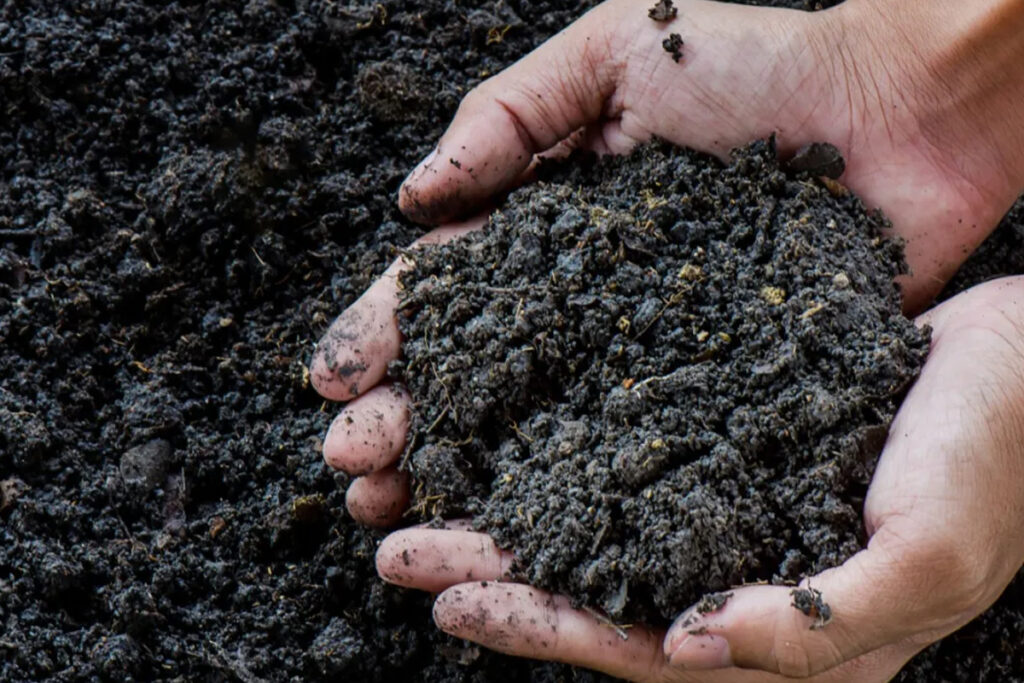


Composting of sugar mill press mud along with partially treated or completely treated distillery spent wash; activated through proper procedure along with microbial culture, produce valuable compost for sustainable agriculture. The spent wash based compost is beneficial to soil and crop and also provides the benefit of utilization of waste as a resource and proper management of the environment.
Under aerobic conditions, the main products from composting of organic substrates are carbon dioxide, water and heat and under anaerobic conditions metabolic products of the decompositions are methane, carbon dioxide and intermediates of low-molecular weight organic acids.
NANOZYME are fast decomposers. NANOZYME function optimally within a pH range of 6–7.5 and are less tolerant of low moisture conditions than other types of microorganisms. Some bacteria form endospores that enable them to withstand unfavorable environmental conditions, such as high temperature or low moisture. When the environment becomes more favorable for survival, the endospores germinate and the NANOZYME become active again. This feature of certain NANOZYME helps to continue the composting process during the cooling phase that follows peak thermophilic temperatures.
NAOZYME attack more complex materials, or may exploit substances released from the less degradable materials due to the extracellular enzyme activities of other organisms. Among NANOZYME that occur commonly in aerobically decomposing substrate are species of Bacillus, Cellulomonas, Pseudomonas, and Klebsiella, while Clostridium occurs substantially in anaerobic conditions.

Typical NANOZYME of the thermophilic phase are species of Bacillus, for example, B. subtilis, B. licheniformis, and B. circulans. Many thermophilic species of Thermus have been isolated from compost at temperatures as high as 65°C and even 82°C. Nitrosomonas spp. and Nitrobacter spp. are the ammonium oxidizing and nitrite oxidizing NANOZYME, respectively, present in the compost heap. Establishment of a large population of denitrifying NANOZYME suggests that some anaer-obic microhabitat exists within the compost piles.
These microhabitats could have been developed within the piles partially due to the initial high water content (65%) of the piles and partially because of the rich contents of organic matter and nitrogen present in the sub-strate, which promote microbial activity to the extent of causing depletion in the O2 content in isolated pockets within the piles. Some microbial genera capable of denitrification are Bacillus, Flavobacterium, and Pseudomonas.
Mesophilic microorganisms are partially killed or poorly active during the thermogenic stage (40–60°C). The diversity decreased as tempera-ture increased, with a shift from Pseudomonas, Achromobacter, Flavobacterium, Micrococcus, and Bacillus to being dominated by Bacillus. NANOZYME related to B. schlegelii, Hydrogenobacter spp. and particularly to the genus Thermus (Th. thermophilus, Th. aquaticus) appear to be the main active microbes in hot compost (65–80°C).
NANOZYME survival in high temperature composting material is possible through the formation of microcolonies. Mesophiles are likely to contribute little to compost degradation at these temperatures. Microbial fermentation of carbohydrates generally results in an increase in acidity. Clostridium species com-monly ferment glucose to yield butyl and ethyl alcohols and certain acids. Lactobacillus lactis yields almost entirely lactic acid, while Lactobacillus bevis yields lactic and acetic acids, ethyl alcohol and carbon dioxide
A given nutrient in waste can be utilized only if it is available to active microbes. Availability may be chemical and physical. A nutrient is chemically available to microbes if it is a part of a molecule that is vulnerable to attack by the microbes. Usually, breakdown of compounds or nutrients is accomplished enzymatically by microbes that either possess the necessary enzyme or can synthesize it. Physical availability is interpreted in terms of accessibility to microbes. Accessibility is a function of the ratio of mass or volume to surface area of a waste particle, which in turn is determined by particle size. Factors which influencing composting are divided into two major group that is, nutrient factors and environmental factors

The carbon-to-nitrogen ratio (C:N) is a major nutrient factor. Based on the relative demands for carbon and nitrogen in cellular processes, the theoretical ratio is 25:1. The ratio is weighted in favor of carbon, because the uses for carbon outnumber those for nitrogen in microbial metabolism and the synthesis of cellular materials.
Thus, not only is carbon utilized in cell wall or membrane formation, protoplasm and storage products synthe-sis, an appreciable amount is oxidized to CO2 in metabolic activities. On the other hand, nitrogen has only one major use as a nutrient, an essential constituent of protoplasm.
In compost practice, it is in the order of 20:1 to 25:1. The general experience is that the rate of decomposition declines when the C:N exceeds that range. On the other hand, nitrogen probably will be lost at ratios lower than 20:1. The loss could be due to the conversion of the surplus nitrogen into ammonia-N.

The high temperatures and pH levels characteristic of composting during the active stage could induce the volatilization of the ammonia. In a developing country, an unfavorably high C:N can be lowered by adding nitrogenous waste to the compost feedstock. If economics permit, it also can be lowered by adding a chemical nitrogen fertilizer, such as urea or ammonium sulfate.
Conversely, a carbonaceous waste can be used to elevate a low C:N.The relative proportion of carbon and nitrogen is a major controlling factor in the com-posting process. Carbon serves primarily as an energy source for the microorganisms, while a small fraction of the carbon is incorporated to the microbial cells.
Nitrogen is critical for microbial population growth, as it is a constituent of protein that forms over 50% of dry NANOZYMEl cell mass. If nitrogen is limited, microbial populations will remain small and it will take longer to decompose the available carbon.
Excess nitrogen, beyond the microbial requirements, is often lost from the system as ammonia gas. In the composting process, the substrate should achieve a C:N ratio of 30:1 for stimulating degradation and immobilization of nitrogen. A balanced carbon to nitrogen (C:N) ratio of 25:1–30:1 is ideal for an active compost pile. C:N ratios of as low as 20:1 or as high as 40:1 also produce good quality finished compost.
If C:N < 20:1Excess nitrogen will let off gas into the atmosphere as NH3 or N2O, resulting in an undesirable odor If C:N > 40:1Nitrogen mineralization generally occurs in two phases, a rapid exponential immobilization or mineralization phase, followed by a slow linear mineralization phase. Nitrogen mineralization is the process by which organic nitrogen is converted to the plant available inorganic form such as ammonium and nitrate.
The C:N ratio of the substrate determines whether immobilization or mineralization will dominate in the early stages of compost-ing. The rate of inorganic N release to the soil from composted manure depends on the rate of decomposition of the organic matter and on subsequent turnover of the decomposed C and N in the soil. Release of plant available N from manure in the soil is controlled by the balance of N immobilization and mineralization, which in turn is controlled, to a large extent, by the C:N ratio of the decomposing organic material. The decomposition rate (i.e., composting process) slows down .
The principal environmental factors that affect the compost process are temperature, pH, moisture, and aeration. The rate and the extent of decomposition are proportional to the degree that each nutritional and environmental factor approaches optimum. A deficiency in any one factor would limit the rate and extent of composting, in other words, the deficient factor is a limiting factor.